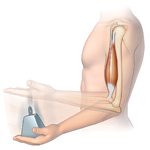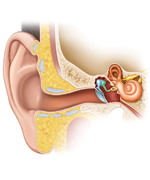Mechanoreceptors are sensory receptors that respond to mechanical (physical) forces. Physical distortion of a mechanoreceptor’s plasma membrane causes ion channels in the membrane to open. Ions flow through the channel, altering the membrane potential of the cell.
The resulting receptor potential is graded, or proportional, to the intensity of the stimulus. The receptor potential may trigger an action potential in the mechanoreceptor itself or simply result in a graded release of neurotransmitter from the mechanoreceptor, in which case a postsynaptic neuron may fire action potentials. The rate of action potentials tells the central nervous system how strong the stimulus is that impinges on the mechanoreceptor.
A considerable diversity of mechanosensory cells involved in many sensory systems has evolved. The functions of these cells range from interpreting skin sensations, to sensing tension on muscles and joints, to hearing.

|
The skin has receptors that detect touch, pressure, and pain stimuli. |

|
Muscle spindles and Golgi tendon organs are sensitive to the amount of load placed on them. |

|
Hair cells in the inner ear encode the frequency and intensity of sound waves. |
Click on the Next button below.

